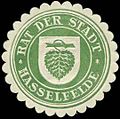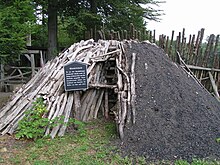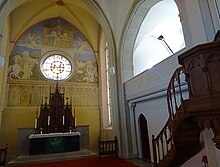City of Hasselfelde
|
City of Hasselfelde
City of Oberharz am Brocken
|
|
|---|---|
| Coordinates: 51 ° 41 ′ 23 " N , 10 ° 51 ′ 22" E | |
| Height : | 455 m above sea level NN |
| Area : | 74.28 km² |
| Residents : | 2904 (December 31, 2008) |
| Population density : | 39 inhabitants / km² |
| Incorporation : | January 1, 2010 |
| Postal code : | 38899 |
| Area code : | 039459 |
|
Location of the city of Hasselfelde in Oberharz am Brocken
|
|
|
Hasselfelde 1654/1658 ( Merian / Topographia Braunschweig Lüneburg)
|
|
City of Hasselfelde is a district of the city of Oberharz am Brocken and has been a state-approved climatic health resort in the Harz district in Saxony-Anhalt since 2002 .
geography
Hasselfelde is located on the high plateau in the Lower Harz , in a small depression through which the Hassel flows. The immediate vicinity of the place is not forested and is used for agriculture.
Local division
In addition to the town center, the Rotacker district belongs to Hasselfelde.
history
The place was first mentioned in 1043 and received city rights in 1222 . In the Ottonian times there was a royal hunting farm in Hasselfelde . The Servite monastery in Hasselfelde existed from 1277 to around 1298.
From 1537 to 1558, Hasselfelde and Stiege were pledged to the Counts of Stolberg for 25,000 guilders .
In 1807 the city was incorporated into the Kingdom of Westphalia created by Napoleon . Hasselfelde became the administrative seat of the canton Hasselfelde . The canton formed part of the Blankenburg district in the Saale department . After the dissolution of the Kingdom of Westphalia in 1813 and the constitution of the Duchy of Braunschweig , the state administration was reorganized. Hasselfelde became the administrative seat of the Hasselfelde office in the Duchy of Braunschweig.
The city burned down almost completely several times in the past, most recently in 1893. The St. Antonius Church was also rebuilt several times; their community today belongs to the provost of Bad Harzburg .
Trautenstein was incorporated on January 1, 2002.
On January 1, 2010, the city of Hasselfelde merged with the communities of Elend , Sorge , Stiege and Tanne and the cities of Elbingerode (Harz) and Benneckenstein (Harz) to form the city of Oberharz am Brocken.
On July 1, 2014, the new municipal constitutional law of the state of Saxony-Anhalt came into force. In its §14 (2) the municipalities are given the opportunity to assign this designation to the districts that were towns before the incorporation. The city of Oberharz am Brocken has made use of this regulation. Their new main statutes came into force on June 26, 2015. In §3 (1) the districts are listed with their official names.
coat of arms
Blazon : "In silver, a fallen green hazel leaf growing out of a green branch."
Hasselfelde did not have an officially approved coat of arms until 2000, but it has been proven in customary law since 1653 that it showed a leaf of the hazel bush and is therefore to be regarded as a talking coat of arms. It cannot be proven whether the coat of arms was officially approved earlier. Several major fires that left the place and the town hall in ruins have destroyed many historical documents, so that no evidence can be provided.
The coat of arms shown here has only been changed slightly compared to the classic model in order to adapt it to the heraldic style. The contours were executed with a uniform line width and hatching in the leaf and branch was neglected. The Magdeburg municipal heraldist Jörg Mantzsch carried out the redesign and incorporation into the approval process .
The city colors are green - silver (white).
Coat of arms on a seal mark with standing
Culture and sights
Blauvogel holiday village
Because of its central location in the middle of the Harz Mountains, the place is popular with tourists. After the fall of the Wall, the Blauvogel nature adventure village with a large number of holiday homes was built in the Rotacker district .
Western town
On the eastern edge of the city, a replica of a western town , Pullman City Harz, was built as a tourist attraction in 2000 , the managing director of which was the mayor of Hasselfelde at the same time. On April 8, 2006, the park passed into new ownership.
Harzköhlerei
The Harzköhlerei Stemberghaus is located on the road to Blankenburg . There, traditional charcoal is still made in an open-air museum . The site also includes the Köhlerhütte restaurant, which was only built in 2012, and a souvenir shop.
hike
From Hasselfelde, excursions in all directions and natural landscapes have been possible since the opening of the inner-German border . The southern route of the Harzer Hexenstieg leads through the city past the Hasselvorsperre in the direction of the Stemberghaus charcoal factory.
Harz narrow-gauge railway
In Hasselfelde there is a train station for the Harz narrow-gauge railway . A branch of the Selketalbahn from the direction of Stiege ends here .
Excursion destinations
The most important sights in the area are the Brocken , the Rübeland stalactite caves , several show mines from the old mining tradition of the Harz, the half-timbered towns of Wernigerode , Quedlinburg and Stolberg , Rosstrappe and Hexentanzplatz in the Bodetal, the imperial town of Goslar , the Joseph Cross on the Großer Auerberg, the Rappbode- Dam with the Hasselvorsperre and the Carlshausturm on the 626 m high Carlshaushöhe .
Monuments
- Memorial for Hermann Blumenau at the train station.
- Memorial stone from 1967 in the cemetery for ten unknown concentration camp prisoners who were murdered and buried there by SS men on a death march from the Dora-Mittelbau concentration camp in April 1945
- Memorial stone in the cemetery: "In memory of 30 German and 60 American soldiers. April 1945"
- Memorial stone from 1993 on the market square for the victims of war and violence. During the GDR era, the market square was called the Peace Square . The memorial stone bore the inscription "We want peace". After the fall of the Wall, the sign was removed, rededicated in 1993 as a memorial stone for the victims of war and violence and moved a few meters to the north. Drilled holes in the stone show that it was not originally used as a memorial stone.
Regular events
Three big festivals take place in Hasselfelde every year. On Holy Saturday organized by the local association will Osterfeuer Easter fire ignited. The highlight of the year in Hasselfelde is the Schützenfest , which takes place at Whitsun and, like the Koehler Festival, has a fixed date on the first weekend in August.
The place is one of the eight places in which the tradition of the finch maneuver, which has been recognized as an intangible world cultural heritage since 2014, is still cultivated in the Harz Mountains .
Economy and Infrastructure
traffic
Hasselfelde is on the federal highways 242 and 81 , which form important west-east and north-south traffic routes through the Harz Mountains . The district can be reached by train via the network of the Harz narrow-gauge railways from Nordhausen as well as from Gernrode and Quedlinburg via the Selketalbahn . In the center of the village is the bus station, where the lines of the Harz transport company and the Südharz transport company meet; There are bus connections in all directions. There is also an ultra-light airfield on the edge of the western town .
For the development of the postal system in Hasselfelde see:
education
In Hasselfelde there is not only a kindergarten but also the Dr. Hermann Blumenau Elementary School. The secondary school of the same name was closed in 2006.
Religions
Evangelical Lutheran Church
The Protestant St. Antonius Church is located in Hasselfelde and belongs to the provost of Bad Harzburg . The church, built according to plans by the Brunswick master builder Carl Theodor Ottmer ( Schinkel student ), was inaugurated in 1851 . The altar and pulpit in neo-Gothic style were created by sculptor Wilhelm Sagebiel from Braunschweig. A special feature of the church in terms of art history is the mural on the altar wall created in 1902 by court painter Adolf Quensen , Braunschweig, which was uncovered and restored in 2002 .
Roman Catholic Church
The Catholic Chapel of Mary of St. Rosary was abandoned in 2006. As a result of the Second World War , Catholic expellees had also settled in Hasselfelde , which had been evangelical since the Reformation , and the Hasselfelde Kuratie was established in 1951 . Since Hasselfelde belonged to the diocese of Hildesheim at that time , Wilhelm Lehnert (1915-2010) was a curate who was transferred to Hasselfelde from there . In 1957 the chapel was built by converting a sheep pen. In 2002 Pastor Lehnert retired at the age of 87 and moved to a nursing home in Nordhausen. The last service took place in the chapel on January 29, 2006. Today, Catholic services are held by the parish of St. Josef (Blankenburg) in the Protestant St. Antonius Church in Hasselfelde.
Personalities
Sons and daughters of the district
- Johann Wilhelm Ludwig von Luce (1756–1842), writer, clergyman, physician, regional historian of the Estonian island of Ösel
- Hermann Blumenau (1819–1899), founder and namesake of the Brazilian city of Blumenau
- Wilhelm Dunker (1829–1902), newspaper editor and poet
- Gerhard Zucker (1908–1985), rocket technician
- Reiner Schomburg (* 1953), politician
- Kerstin Moring (* 1963), cross-country skier and biathlete
- Thomas Gaevert (* 1964), journalist and freelance author
Personalities associated with Hasselfelde
- Andreas Werckmeister (1645–1706), musician and music theorist , introduced the well-tempered tuning for keyboard instruments and worked as an organist in Hasselfelde from 1664 to 1674 ,
- Karin Krebs (* 1943), former GDR athlete, now lives in the village
literature
- Berent Schwineköper (Hrsg.): Handbook of the historical sites of Germany . Volume 11: Province of Saxony Anhalt (= Kröner's pocket edition . Volume 314). 2nd, revised and expanded edition. Kröner, Stuttgart 1987, ISBN 3-520-31402-9 , pp. 198-199.
- Karl Böhnstedt: History of the city of Hasselfelde , Vol. 1 From the settlement of the Harz Mountains to 1945 , Hasselfelde 1974
Web links
Individual evidence
- ↑ Specification of health resorts and recreational areas in Saxony-Anhalt (as of March 2017) ( Memento of the original from December 30, 2017 in the Internet Archive ) Info: The archive link was inserted automatically and has not yet been checked. Please check the original and archive link according to the instructions and then remove this notice.
- ↑ StBA: Changes in the municipalities in Germany, see 2002
- ↑ StBA: Area changes from January 01 to December 31, 2010
- ↑ Local constitution law of the state in the version of July 1, 2014
- ^ Main statute of the city of Oberharz am Brocken in the version of June 26, 2015
- ↑ website of Schauköhlerei Stemberg , accessed on May 8, 2014.
- ^ Website of the Ev.-luth. Parish association Hasselfelde with stairs and Allrode , accessed on May 8, 2014.
- ^ History of the Catholic chapel in Hasselfeld on the website of the Diocese of Magdeburg , accessed on October 29, 2014.
- ^ Website of the Catholic parish of St. Josef Blankenburg , accessed on May 8, 2014.





















